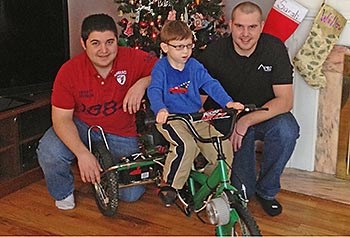Tricycle Project to Help Youngster with Cerebral Palsy

01/25/2013
By Edwin L. Aguirre
“It was a great feeling to help a child with disability,” says Anthony Capone.
He and fellow electrical engineering student Derek Dempsey used assistive design technology to create a “hybrid power tricycle” for their client — a 4-year-old boy named Pierce who is afflicted with cerebral palsy, a brain disorder that affects a person’s mobility and mental development.
“Knowing you improved the quality of someone’s life is very powerful,” notes Capone. “When Pierce first saw the tricycle, he was so excited that he couldn’t stop smiling. His parents told us he did not smile often, so knowing our project made him happy was very rewarding.”
An Early Christmas Present
Capone and Dempsey personally delivered the tricycle to Pierce’s home in Pittsburgh in December, just three days before Christmas. The event was featured in a local broadcast by WTAE-TV Channel 4 News.
The project was part of the students’ senior capstone project in the College of Engineering’s Assistive Technology Program. The two received their bachelor’s degrees last fall and both are now enrolled in the University’s master’s degree program in electrical engineering.
Founded in 1991 by Prof. Donn Clark, the Assistive Technology Program pits students against problems that hinder the functional capabilities of people with physical or mental challenges. Parts for the projects are funded by a grant from the National Science Foundation, as well as corporate and private donors and by alumni endowment. The students supply the labor and the finished products are delivered to clients free of charge.
“The total cost for the tricycle parts is around $800,” says Capone.
A Sense of Independence
“We designed the tricycle so it resembles a regular bike and is relatively easy to move around,” explains Dempsey.
The tricycle uses a sensor that reads how fast Pierce is pedaling and sends a signal to a microcontroller. The microcontroller calculates how much power to send to the motor controller, which then revs up the electric motor to spin the tricycle’s front wheel.
“Basically, Pierce can ride the trike and the motor will assist him while he pedals,” says Dempsey. “Pierce’s cerebral palsy has left him with poor core and leg muscle strength. Riding the tricycle provides important exercise to improve his physical condition.”
Adds Capone: “After conducting research, we learned that our tricycle is the only one that matches its speed to that of the rider’s pedaling. The others are either all-human-powered or have a hand throttle on them, but there are none that combine the two features. Our design gives the rider a feeling of independence while exercising. In the case of Pierce, this is very important.”
Capone and Dempsey also incorporated several safety features on the tricycle.
“One is a wireless shut-off switch for the parents to operate in case Pierce is riding the tricycle out toward, say, the street,” explains Dempsey. “The switch has a range of about 300 feet. Another safety feature is a mechanism that prevents the front-wheel motor from spinning until the hand brake is released.”
“We entered our tricycle design in a number of student competitions,” says Capone. “If things work out well, we could decide to start producing these trikes for the general public. Working for ourselves would be great.”
